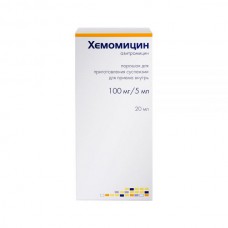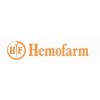Expiration date: 07/2025
The composition and form of issue:
Capsules. 1 capsule contains:
azithromycin 250 mg
excipients: lactose anhydrous, corn starch, magnesium stearate, sodium lauryl sulfate
in blistere 6 PCs. in cardboard pack 1 blister.
Powder for preparing the suspension for oral administration, 5 ml contains:
azithromycin 100 mg
corresponds to azithromycin dihydrate 104, 809 mg
auxiliary substances: xanthan gum, sodium saccharinate, calcium carbonate, silicon colloidal dioxide, sodium phosphate anhydrous, sorbitol, Apple, strawberry, cherry flavors
in bottles of dark glass on 11, 43 g (complete with a measuring spoon) in a pack of cardboard 1 set.
Powder for preparing the suspension for oral administration, 5 ml contains:
azithromycin 200 mg
auxiliary substances: xanthan gum, sodium saccharinate, calcium carbonate, silicon colloidal dioxide, sodium phosphate hydrate, sorbitol, fruit flavors
in a bottle (complete with a measuring spoon) in a pack of cardboard 1 set.
Tablets, film-coated. 1 tablet contains:
azithromycin 500 mg
(in the form of azithromycin dihydrate)
auxiliary substances: silicate microcrystalline cellulose, MCC, sodium carboximetilkrahmal (type A) povidone magnesium stearate talc silica colloidal anhydrous
shell: titanium dioxide talc copovidone ethyl cellulose macrogol 6000 indigokarmin (indigotin) E132 dye lacquer green 8% (indigokarmin (indigotin) E132, quinoline yellow E104)
in blister 3 PCs the paper cartons of 1 blister.
Description of dosage form:
Capsules: light blue, size . The contents of capsules-white powder.
Powder for preparing the suspension for oral administration: white or almost white with a fruity smell. The finished suspension is almost white with a fruity smell.
Tablets: round, biconvex, film-coated grayish-blue.
Characteristic:
Macrolide broad-spectrum antibiotic subgroups azalidov.
Pharmacokinetics:
Quickly absorbed from the digestive tract (due to its resistance to acidic medium and lipophilicity). Once inside the dose of 500 mg Modosteady 2, 5-2, 96 h and is 0, 4 mg/l. Bioavailability is 37%.
It penetrates well into the respiratory tract, organs and tissues of the urogenital tract, into the skin and soft tissues. High concentrations in tissues (10-50 times higher than in blood plasma) and a long half-life are due to low binding of azithromycin with plasma proteins, as well as its ability to penetrate eukaryotic cells and concentrate in an environment with a low pH value surrounding lysosome. This determines the large apparent volume of distribution (31, 1 l/kg) and the high plasma clearance. The ability of azithromycin to accumulate mainly in lysosomes is especially important for the elimination of intracellular pathogens. The phagocytes deliver azithromycin to the places of infection, where it is released in the process of phagocytosis. The concentration of azithromycin in the foci of infection is higher than in healthy tissues (on average 24-34%) and correlates with the degree of inflammatory edema. Despite the high concentration in phagocytes, azithromycin has no significant effect on their function.
Azithromycin is preserved in bactericidal concentrations in the focus of inflammation within 5-7 days after taking the last dose, which allowed to develop a short (three - and five-day) course of treatment.
Demetiliruetsa in the liver with formation of inactive metabolites.
Displayed in 2 stages: T1 / 2pervoy phase (in the range of 8-24 h) — 14-20 h, the second (in the range of 24-72 h) - 41 h, which allows you to take the drug once a day.
Description of the pharmacological action:
In high concentrations has a bactericidal effect. Active against gram-positive cocci (Streptococcus pneumoniae, Streptococcus pyogenes, Streptococcus agalactiae, Streptococcus group CF and G, Staphylococcus aureus, Staphylococcus viridans), gram-negative bacteria (Haemophilus influenzae, Moraxella catarrhalis, Bordetella pertussis, Bordetella parapertussis, Legionella pneumophila, Haemophilus ducreyi, Campylobacter jejuni, Neisseria gonorrhoeae, Gardnerella vaginalis), some anaerobic bacteria (Bacteroides bivius, Clostridium perfringens, Peptostreptococcus spp.) as well as Chlamydia trachomatis, Mycoplasma pneumoniae, Ureaplasma urealyticum, Treponema pallidum, Borrelia burgdorferi.Inactive against gram-positive bacteria resistant to erythromycin.
Indications:
Infectious and inflammatory diseases caused by microorganisms sensitive to the drug:
- infections of the upper respiratory tract and ENT organs (angina, sinusitis, tonsillitis, otitis media)
- scarlatina
- infections of the lower respiratory tract (bacterial and atypical pneumonia, bronchitis)
- infections of the skin and soft tissues (erysipelas, impetigo, secondary infected dermatoses)
- urogenital tract infections (uncomplicated urethritis and/or cervicitis)
- Lyme disease (borreliosis), for the treatment of the initial stage (erythema migrans)
- diseases of the stomach and duodenum associated with Helicobacter pylori(as part of combination therapy).
Contraindications:
Capsules
- hypersensitivity (including to other macrolides)
- severe violations of the liver and kidneys
- pregnancy
- breast-feeding (at the time of treatment suspend)
- children under 12 years old.
Powder for suspension preparation
- hypersensitivity (including to other macrolides)
- hepatic and/or renal failure
- breast-feeding (at the time of treatment suspend)
- children's age up to 12 months (for powder 100 mg — up to 6 months).
With caution:
- pregnancy (use is possible if the expected effect of therapy exceeds the potential risk to the fetus)
- arrhythmias (ventricular arrhythmias and Qt prolongation are possible)
- children with severe impaired liver or kidney function.
Tablets
- hypersensitivity (including to other macrolides)
- hepatic and/or renal failure
- children under 12 years old
- lactation.
With caution:
- pregnancy
- arrhythmia (possible ventricular arrhythmias and prolongation of Qt interval)
- children with severe impaired liver or kidney function.
Application during pregnancy and breast-feeding:
Capsules: contraindicated in pregnancy.
Powder for the preparation of suspensions, tablets: during pregnancy, the use is possible if the expected effect of therapy exceeds the potential risk to the fetus.
Total for all dosage forms:at the time of treatment should stop breastfeeding.
Side effect:
Capsules
From the digestive tract: nausea, diarrhea, abdominal pain are rare — vomiting, flatulence, transient increase in liver enzymes.
Dermatological reactions:in some cases a rash.
Powder for the preparation of suspensions, tablets
From the digestive tract: diarrhea (5%), nausea (3%), abdominal pain (3%) dyspepsia, flatulence, vomiting, melon, cholestatic jaundice, increased liver transaminases (1% or less) in children — constipation, anorexia, gastritis.
From the side of cardiovascular system:palpitations, chest pain (1% or less).
From the nervous system: dizziness, headache, vertigo, drowsiness in children — headache (in the treatment of otitis media), hyperkinesia, anxiety, neurosis, sleep disorders (1% or less).
From the genitourinary system: vaginal candidiasis, nephritis (&le1%).
Allergic reactions:rash, photosensitivity, angioedema.
Other: fatigue in children-conjunctivitis, itching, urticaria.
For powder for the preparation of a suspension for oral administration (optional): in extremely rare cases — oral candidiasis.
Drug interaction:
Antacids (aluminum - and magnesium-containing), ethanol and food slow down and reduce absorption. In the joint appointment of warfarin and azithromycin (in normal doses), changes in PV were not revealed, however, given that the interaction of macrolides and warfarin may increase anticoagulant effect, patients need careful control of PV.
Increases the concentration of digoxin.
Ergotamine and dihydroergotamine: increased toxicity (vasospasm, dysesthesia).
Decreases the clearance and enhances the pharmacological effect triazolama.
Slows excretion, increases concentration in plasma and toxicity zikloserina, indirect anticoagulants, methylprednisolone, felodipine, and drugs undergoing microsomal oxidation (carbamazepine, terfenadine, cyclosporine, gexobarbitala, ergot alkaloids, valproic acid, disopyramide, bromocriptine, phenytoin, oral gipoglikemicakie means, theophylline and other xantinove derivatives) — due to inhibition of microsomal oxidation in hepatocytes.
Lincosamine weaken the effectiveness of tetracycline and chloramphenicol — strengthen. Pharmacologically incompatible with heparin.
Method of application and doses:
Inside for 1 hour before meals or 2 hours after meals, 1 time per day.
Capsules, tablets
With infection of the upper and lower respiratory tract, 500 mg/day for 3 days (course dose — 1, 5 g).
With infections of the skin and soft tissues— 1 g/day on the first day at 1 reception, then — 0, 5 g/day daily, from the 2nd to the 5th day (course dose-3 g).
In uncomplicated urethritis and/or servicesenhanced once 1.
In Lyme disease (borreliosis)for the treatment of the initial stage (erythema migrans) appoint 1 g in the 1st day and 500 mg daily from the 2nd to the 5th day (course dose-3 g).
In diseases of the stomach and duodenum associated with Helicobacter pylori, appoint 1 g per day for 3 days as part of combination therapy.
In case of missing 1 dose of the drug, the missed dose should be taken as early as possible, and the following — with a break of 24 hours.
Powder for the preparation of the suspension. The bottle is gradually added water (distilled or boiled and cooled) to the mark. The contents of the vial are thoroughly shaken until a homogeneous suspension is obtained. If the level of the prepared suspension is below the label of the bottle, re-add the water to the label and shake.
The prepared suspension is stable at room temperature for 5 days.
Before use, the suspension should be shaken.
Immediately after taking the suspension, the child should be allowed to drink a few SIPS of tea in order to rinse and swallow the remaining amount of the suspension in the oral cavity.
In case of missing 1 dose of the drug missed dose should be taken as soon as possible, and the following-with a break of 24 hours.
Overdose:
Symptoms: severe nausea, temporary hearing loss, vomiting, diarrhea.
Special instruction:
It is necessary to observe a break of 2 hours with the simultaneous use of antacids.
Hypersensitivity reactions in some patients may persist after the withdrawal of treatment (requires specific therapy under the supervision of a physician).





